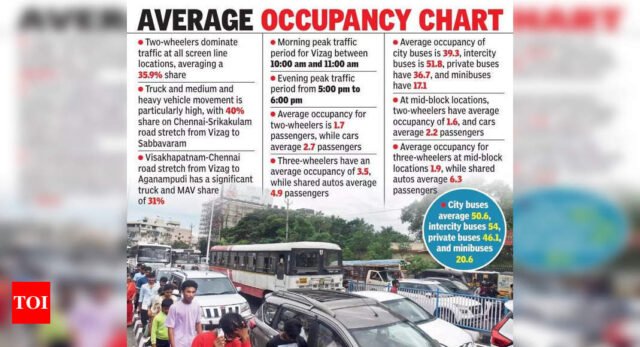Visakhapatnam: Andhra Pradesh metro rail corporation limited is planning to update the comprehensive mobility plan (CMP) for Visakhapatnam in response to a request from the Union govt. This update is essential to support the proposed metro rail project, as the original CMP was developed in 2018, and its validity is limited to five years. Given the significant changes in traffic volumes, mobility and infrastructural needs, a revised version is necessary not only for the metro rail project but also for related public transportation services, including bus routes, feeder services for the metro, road network expansion, and new alignments/routes.
The primary goal of this update is to increase public transport share from the current 40% to somewhere between 50% and 55%. To achieve this, it is crucial to complete certain missing links in the road network to ensure balanced traffic distribution across major routes. This includes the Simhachalam BRTS corridor connected to NH-16, as well as routes through NAD, Lankelapalem, Sontyam-Anandapuram, Peda Narava, Gangavaram-Tallapalem, and the Gajuwaka bypass, among others. Previous studies indicated that the highest traffic flow occurs at NAD junction, with 3.57 lakh passenger car units per day. During peak hours, traffic at key intersections can account for 8-10% of total daily traffic.
For instance, at Birla Junction on the national highway, peak traffic occurs between 5 pm and 6 pm and comprises 10.1% of the day’s total traffic. Similarly, at YSR Stadium near PM Palem, the peak hour is from 6 pm to 7 pm, accounting for 9.6% of the total traffic.
A source from the metro rail corporation confirmed that the CMP will be updated as requested by Union govt.
“As the new CMP will be valid for the next five years, this will facilitate smooth execution of the planning and execution of the metro rail project,” said the source.
According to the service level benchmarking conducted in the previous CMP, four levels of service (LoS) were defined, with LoS 1 representing the highest performance level and LoS 4 the lowest.
Visakhapatnam’s public transport system, primarily operated by APSRTC, achieves a 100% presence of organised public transport. However, its availability per 1,000 residents is only 0.29, indicating a LoS of 2. Average bus waiting times range from 5 to 10 minutes (LoS 3), while public transport coverage spans 250 km over a city area of 643 sq km, also resulting in a LoS of 3.
Pedestrian infrastructure scores an LoS of 2, with only 23% of the surveyed network featuring paved footpaths, and many intersections failing to meet pedestrian wait time standards. Non-motorised transport facilities are minimal, receiving a LoS of 4. The usage of intelligent transport systems is low, with traffic surveillance at just 8.84% (LoS 4) and no synchronised signals.
Travel speeds for personal vehicles average 28 km/h, while public transport averages 18 km/h, both reflecting a LoS of 2.
The primary goal of this update is to increase public transport share from the current 40% to somewhere between 50% and 55%. To achieve this, it is crucial to complete certain missing links in the road network to ensure balanced traffic distribution across major routes. This includes the Simhachalam BRTS corridor connected to NH-16, as well as routes through NAD, Lankelapalem, Sontyam-Anandapuram, Peda Narava, Gangavaram-Tallapalem, and the Gajuwaka bypass, among others. Previous studies indicated that the highest traffic flow occurs at NAD junction, with 3.57 lakh passenger car units per day. During peak hours, traffic at key intersections can account for 8-10% of total daily traffic.
For instance, at Birla Junction on the national highway, peak traffic occurs between 5 pm and 6 pm and comprises 10.1% of the day’s total traffic. Similarly, at YSR Stadium near PM Palem, the peak hour is from 6 pm to 7 pm, accounting for 9.6% of the total traffic.
A source from the metro rail corporation confirmed that the CMP will be updated as requested by Union govt.
“As the new CMP will be valid for the next five years, this will facilitate smooth execution of the planning and execution of the metro rail project,” said the source.
According to the service level benchmarking conducted in the previous CMP, four levels of service (LoS) were defined, with LoS 1 representing the highest performance level and LoS 4 the lowest.
Visakhapatnam’s public transport system, primarily operated by APSRTC, achieves a 100% presence of organised public transport. However, its availability per 1,000 residents is only 0.29, indicating a LoS of 2. Average bus waiting times range from 5 to 10 minutes (LoS 3), while public transport coverage spans 250 km over a city area of 643 sq km, also resulting in a LoS of 3.
Pedestrian infrastructure scores an LoS of 2, with only 23% of the surveyed network featuring paved footpaths, and many intersections failing to meet pedestrian wait time standards. Non-motorised transport facilities are minimal, receiving a LoS of 4. The usage of intelligent transport systems is low, with traffic surveillance at just 8.84% (LoS 4) and no synchronised signals.
Travel speeds for personal vehicles average 28 km/h, while public transport averages 18 km/h, both reflecting a LoS of 2.







